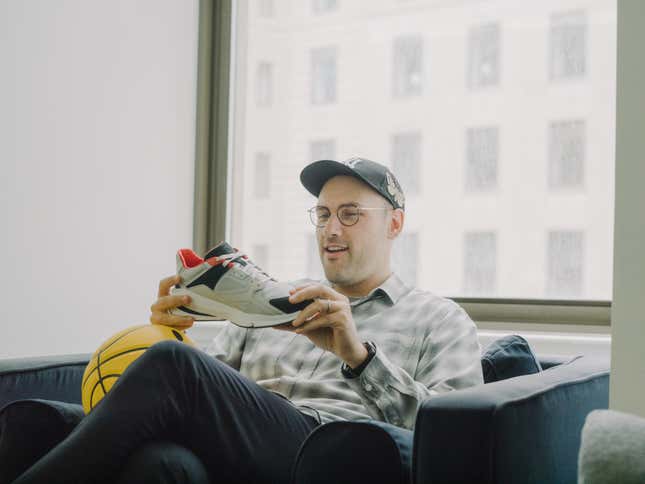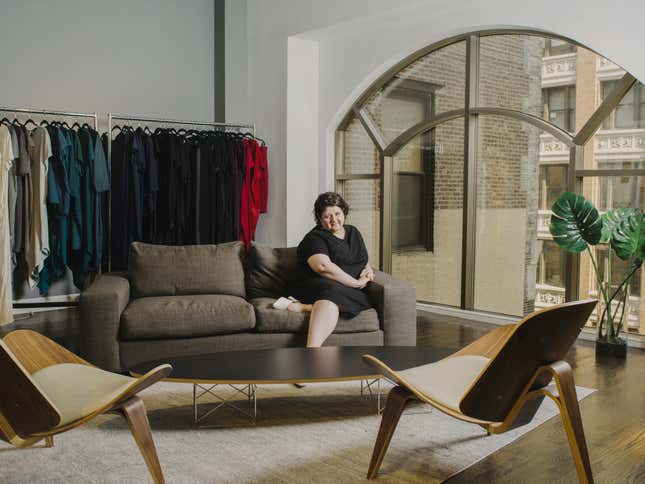Subscribe to the Quartzy newsletter to receive this in your inbox each Friday.
The fashion set is currently on its semi-annual tour of fashion weeks, from New York to London, and now Milan. The loudest takeaway thus far has been that the media is batshit for Batsheva, a collection of high-necked, long-sleeved, and generously frilled pioneer lady dresses from the New York designer Batsheva Hay. Breathless coverage from the New York Times, the Washington Post, and the New Yorker, among others suggests that perhaps the Urban Prairie Girl is on her way to unseating the Silver Lake Shaman (and the Brooklyn Lumberjack before her) as fashion’s current muse.
I enjoyed the New Yorker profile of Hay, especially as side-by-side reading with Cathy Horyn’s New York Magazine profile of Rachel Comey, one of my all-time favorite designers of clothing that I actually wear. It’s exciting to watch these women find success by dressing women as they like to dress themselves.
If you’re feeling this pioneer dress thing but can’t get your hands on (or wrap your head around) Batsheva, the California-based labels Doen and Christy Dawn make slightly more accessible versions. And there’s always vintage Laura Ashley on eBay.
Or, look for Ulla Johnson dresses on The RealReal
The RealReal, if you’re not already addicted, is a luxury online consignment site where people can sell the high-end clothes, accessories, and home goods they no longer use to people happy to buy them at a discount. They’ve recently opened stores in New York and Los Angeles, and have worked with over 9 million customers.

I recently interviewed The RealReal’s chief merchant, Rati Levesque, about how the company uses data to track the desirability of certain items (Cartier Tanks are having a moment) and adjust pricing accordingly. On a personal note, she mentioned setting up an alert in the app for menswear-style coats from Loro Piana and Dries van Noten—a pro-tip for label-specific fashion hunts, or to find the one that got away from a past season.
Redesigning fashion
The interview with Levesque was one in a new Quartzy series of interviews called Redesigning Fashion that Marc Bain, Annaliese Griffin and I did with leaders in the field—you might call them fashion pioneers—who are forging paths we might barely have imagined a decade ago.
Marc Bain spoke with High Snobiety founder David Fischer, who took it back to the Blogspot days, when he started High Snobiety to share his thoughts about streetwear and sneakers. Today, that blog has grown into a publisher and creative agency with more than 9 million monthly visitors to its site and 2.4 million Instagram followers.

“Everything is now a community,” he told Marc. “It’s not a brand dictating to the community what’s cool anymore… That’s why somebody like Virgil Abloh is so successful, because he’s so entrenched in his community. That’s why he DJs four times a week, not because he needs the money, but because he understands that more than anything, he is interacting with this community. We see our audience as a community, and ourselves as an interactive part of that community.”
Universal Standard founder Alexandra Waldman told Annaliese Griffin about how being left out of fashion altogether inspired her to create her label, which makes women’s clothing from sizes 6 to 32, and has attracted some $8.5 million in funding. Waldman discussed the dearth of simple and sophisticated clothes in her size, and the importance of “micro-grading” to ensure styles maintain their integrity as they size up. (Bermuda shorts should not become palazzo culottes.) Just don’t call them “plus-size.”

“I don’t think plus-size clothing has a future,” said Waldman. “The world doesn’t need another plus-size brand. I think what we need to do is take those two branches, the plus-size and the straight-size, and bind them back together and just start making clothes for women, for everyone. From day one we were size 10 to 28. We’re currently 6 to 32, and by next year we will be 00 to 40.”
A modest proposal
Speaking of fashion pioneers, did you—like many millions—watch Instagram influencer Chiara Ferragni’s impossibly lavish wedding festivities in Sicily unfold a couple of weeks ago? When I learned that her nuptials earned the brands whose products were included (including Dior, Lancome, and Alitalia) an estimated $36 million—not a typo!—it all made me feel a little naive, like Steve Martin in the opening scene of the 1991 classic, Father of the Bride.
“I used to think a wedding was a simple affair,” he says, massaging his feet in his confetti-strewn living room. “Boy and girl meet. They fall in love. He buys a ring. She buys a dress. They say, ‘l do.’ I was wrong. That’s getting married. A wedding is an entirely different proposition.”
The intersection of today’s wedding industrial complex and peak social media, Ferragni proved, can be an astonishingly lucrative business proposition. Ferragni got free travel, couture gowns, makeup looks, and lord knows what else, by basically getting her wedding #sponsored. She just had to Instagram a lot.
Is it a little unseemly to put price-tags on one’s memories of such a personal event? Probably! But let’s be honest. Weddings are, in a sense, exercises in personal branding, executed for their intended audiences. In some cases, those audiences might just be one’s grandmother (smoked salmon platter at a Sunday brunch), the groom’s ex-hippie friends from college (Mason jars of signature cocktails), or whoever happens to be at City Hall (whatever!). In others, they may include the FOMO-stricken followers of a wedding-specific hashtag.
In Ferragni’s case, that hashtag—#TheFerragnez—got a cool 67 million engagements. Mazel tov!
Speaking of weddings, I’m going to be in and out over the next few weeks for my own (sans corporate sponsors) so an A+ lineup of Quartz writers, including Corinne Purtill and Annaliese Griffin, will be addressing you while I’m away. You’re in good hands.
In the meantime, have a great weekend!

PS: “The Great British Baking Show” has still got it
Annaliese Griffin is happy to report that The Great British Baking Show, the competition show previously beloved on the BBC and now streaming directly on Netflix for the first time, has still got it. “Go ahead and whip up a traybake and make a cup of tea—it’s still worth watching,” she writes. Even with new hosts and no Mary Berry, she found herself every bit as delighted: “This new collection of passionate amateurs embodies the mix of grandmas who have been whipping up puddings for decades, engineers with a penchant for architectural bakes, moms who make the most spectacular birthday cakes on the block, and contestants whose cultural identities reflect Britain’s colonial past, bringing a wider palette of flavors to the show. Their earnest exuberance and the seriousness with which they glaze a cake or shape a pizza is what carries the show.”

